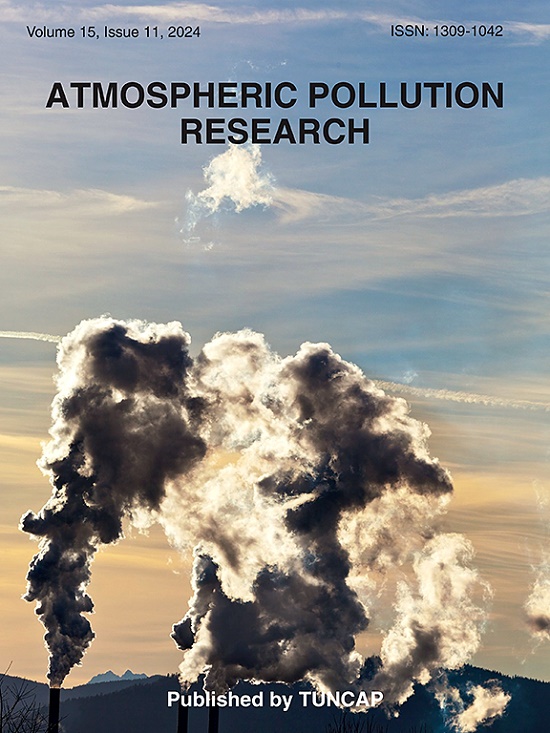Quantitative assessment of urban-rural spatiotemporal heterogeneity in air pollutants using GEE multi-source data across the Anhui province, China
IF 3.9
3区 环境科学与生态学
Q2 ENVIRONMENTAL SCIENCES
引用次数: 0
Abstract
Air pollution in urban areas has garnered considerable attention in recent years. However, from an equity perspective, the air pollution situation in non-urban areas warrants more in-depth investigation. Limited research still exists on the non-urban air pollution. This study examined the urban-rural spatiotemporal heterogeneity of NO2, CO, and O3 in the Anhui Province from 2019 to 2023. Using Google Earth Engine (GEE), ArcGIS, and R language, the analysis integrated TROPOMI column concentration data with natural and social influencing factors. The results revealed the following: (1) The concentrations of NO2, CO, and O3 exhibit a declining trend during the annual plum rain season. NO2 and CO concentrations show inter-annual fluctuating decreases, whereas O3 demonstrates a fluctuating increase. NO2 and CO concentrations are lowest in summer and increase synchronously during autumn and winter. The highest correlation coefficient between NO2 and O3 concentrations occurs in spring, at −0.946. (2) From January to March each year, the maximum concentrations of CO and O3 are more likely to occur in non-urban built-up areas. Compared to 2019, the average area proportions of increased CO and NO2 concentrations in urban built-up areas across all four seasons in 2023 are 8.91% and 4.93%, respectively, significantly lower than those in non-urban built-up areas (91.08% and 95.05%). Except for summer, O3 concentrations show an increasing trend throughout the entire province. (3) The standard deviations of the multi-year average concentrations of CO, NO2, and O3 among the 16 prefecture-level cities are 0.002, 2.19 × 10−5, and 0.0027, respectively. This suggests that the variation in NO2 pollution among cities is relatively small, while the spatial imbalance of O3 pollution is pronounced, with the highest average O3 concentrations observed in cities in northern Anhui. (4) The correlation coefficients between each air pollutant and the perimeter-area fractal dimension of water, forests, and buildings exceed 0.64, and the correlation coefficients with the aggregation index of forests and buildings exceed 0.58. These findings indicate that the complexity and dispersion of landscape patterns resulting from human disturbance may have a significant impact on air pollution levels.
基于GEE多源数据的安徽省大气污染物城乡时空异质性定量评价
近年来,城市地区的空气污染引起了相当大的关注。然而,从公平的角度来看,非城市地区的空气污染情况值得更深入的调查。对非城市大气污染的研究仍然有限。研究了2019 - 2023年安徽省NO2、CO和O3的城乡时空异质性。利用谷歌Earth Engine (GEE)、ArcGIS和R语言,将TROPOMI柱浓度数据与自然和社会影响因素进行综合分析。结果表明:(1)梅雨季节NO2、CO、O3浓度呈下降趋势;NO2和CO浓度呈年际波动下降,而O3呈年际波动上升。NO2和CO浓度在夏季最低,在秋冬季同步上升。NO2和O3浓度的相关系数在春季最高,为- 0.946。(2)每年1 ~ 3月CO和O3浓度最大值多出现在非城市建成区;与2019年相比,2023年全年城市建成区CO和NO2浓度增加的平均面积占比分别为8.91%和4.93%,显著低于非城市建成区的91.08%和95.05%。除夏季外,全省O3浓度均呈上升趋势。(3) 16个地级市CO、NO2和O3多年平均浓度的标准差分别为0.002、2.19 × 10−5和0.0027。结果表明,NO2污染在城市间的差异较小,而O3污染在城市间的空间不平衡较为明显,其中皖北城市的O3平均浓度最高。(4)各大气污染物与水、森林、建筑周界面积分形维数的相关系数均大于0.64,与森林、建筑聚集指数的相关系数均大于0.58。这些结果表明,人为干扰导致的景观格局的复杂性和分散性可能对空气污染水平产生重大影响。
本文章由计算机程序翻译,如有差异,请以英文原文为准。
求助全文
约1分钟内获得全文
求助全文
来源期刊

Atmospheric Pollution Research
ENVIRONMENTAL SCIENCES-
CiteScore
8.30
自引率
6.70%
发文量
256
审稿时长
36 days
期刊介绍:
Atmospheric Pollution Research (APR) is an international journal designed for the publication of articles on air pollution. Papers should present novel experimental results, theory and modeling of air pollution on local, regional, or global scales. Areas covered are research on inorganic, organic, and persistent organic air pollutants, air quality monitoring, air quality management, atmospheric dispersion and transport, air-surface (soil, water, and vegetation) exchange of pollutants, dry and wet deposition, indoor air quality, exposure assessment, health effects, satellite measurements, natural emissions, atmospheric chemistry, greenhouse gases, and effects on climate change.
 求助内容:
求助内容: 应助结果提醒方式:
应助结果提醒方式:


